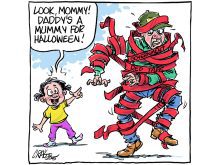The majority of broken bones in livestock are seen in young cattle, caused by trauma associated with a difficult birth or improper handling.
Fractures of the front metacarpal bones and the hind metatarsal bones (above the digits) account for half of all broken bones.
These fractures are caused by excessive force or improper use of chains or ropes on calf legs during assisted calvings.
Cattle also suffer from other fractured bones, particularly the tibia (12 percent of fractures), radius and ulna (seven percent), and humerus (less than five percent).
Read Also

Farmer ownership cannot be seen as a guarantee for success
It’s a powerful movement when people band together to form co-ops and credit unions, but member ownership is no guarantee of success.
Rarely do they suffer pelvic or spinal trauma.
Cattle are excellent candidates for bone healing. They spend most of their time lying down and their bones tend to heal quickly.
They also accept orthopedic
devices much better than other large animals, such as horses.
An animal with a suspected fracture should not be encouraged to stand.
If a calf has a fractured femur, a sharp bone could cut an artery during movement. If a rib is fractured, lung injuries can be worsened if the broken end lacerates a lung lobe when the animal attempts to stand.
A large bone fracture in an older animal could become compound – the bone breaks through the skin and is contaminated.
A fractured limb may need to be immobilized before moving an animal, but caution is needed when applying a temporary splint.
Splints are only appropriate for lower leg fractures – those below the mid-radius or mid-tibia (well below the elbow or the knee.)
If the fracture is higher on the leg, a splint only adds weight, putting added stress on the fracture.
Temporary splints can be made with two halves of a PCV pipe, placed at 90 degrees to each other.
The leg is first padded and then the splint applied, followed by an elastic bandage, or even duct tape, to hold it in place.
Splints should not be applied like a sandwich. Instead, one should be put on the outside surface of the leg and the other on the back. This provides support in two directions.
If an animal is being transported by trailer, it should be given time to lie down before the vehicle is moved.
The type of repair required will be dictated by the location and nature of the fracture.
If only a digit is broken, a walking block can be glued to the healthy toe to take the weight off the broken one. The animal should be confined for six to 10 weeks. The block is usually worn down by this time so it doesn’t need to be removed.
With fractures below the metacarpus or metatarsus or those involving these joints, a cast can be applied.
To get good bone alignment, the leg needs to be kept taut during cast application. This is often accomplished by drilling holes in the hoof and attaching wires that can be pulled while the animal is restrained with ropes, sedation or anesthesia.
Most casts are made of fibreglass, which provides excellent support and does not weigh much. If increased strength is needed, metal rods can be placed within the cast.
Casts are usually left on for four to 10 weeks, but in rapidly growing calves, they may need to be changed every three weeks.
For bad fractures and those involving upper leg bones, orthopedic surgery may be required to stabilize the bone to allow healing.
Bone surgery is obviously more expensive than splinting and is only warranted in valuable calves.
It is also only practical in calves older than three months. Younger calves have soft bones that are unable to hold the screws used in this type of repair.
The final decision to treat a fractured bone or to ship the animal is based on the cost of the repair, the likely success of treatment, which depends on what bone is fractured, and the value of the animal.
Jeff Grognet is a veterinarian and writer practising in Qualicum Beach, B.C.














